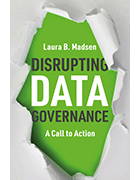Surprising insight on the data governance process
Many enterprise data governance processes have been around for a while. Read on for ways a modern approach can be beneficial, and preview a new book that can update your strategy.
Strong data governance is key to any data management strategy. It's necessary to ensure that you maintain data quality, data lineage and security. A data governance policy will set standards for privacy and access to data, which will ensure an organization maintains high-quality data and provides more trusted data for analysis.
But the traditional data governance process is time-consuming and often difficult to follow. It requires constant communication between different stakeholders in an organization. It also requires that data professionals trust the data they're handling, which can be difficult as many enterprises still don't trust that their data is accurate. The data governance process is also often held up by conflicting priorities coming in from different areas of an organization.
A modern data governance process should focus on being proactive and adaptable. To be successful, a data governance strategy needs to be able to address changing organizational values, large quantities of data, issues that may arise throughout the process and errors that may be found at the end.
In her book, Disrupting Data Governance, published by Technics Publications, Laura B. Madsen discussed the many benefits to changing your current data governance process. Madsen discussed the many benefits to an Agile framework and some of the drawbacks to certain methods found in a more traditional data governance process.
"IT spends a boatload of time in traditional Waterfall methods, proving that they are doing the work rather than doing the work," Madsen wrote.
In the book, Madsen maintained the importance of steps that can enhance your data governance outside of preserving a strict, long-form process. The data governance team is sometimes more important than a long checklist of a procedure. A strong team can also better implement the technology necessary to run a successful strategy.
"What technology can do is solve well-defined problems," Madsen wrote. Knowing what the problems are and how they affect the organization, the data quality or the data governance process is only possible with a knowledgeable team who can identify those problems and find solutions that work.
Data governance is not a one-and-done project. It is a constant program with changing priorities and standards. What is good enough quality for data at one point may not be in the future. A strong cross-functional team can work together to define the metrics necessary to exceed what is good enough throughout the process and keep your data management strategy running smoothly.
In this excerpt from Disrupting Data Governance, Madsen wrote about the many ways to create a data governance process that will continue to work for your data and help your organization's use of high-quality data grow.
Preview Disrupting Data Governance: A Call to Action
Click here to read Chapter 2 of Disrupting Data Governance: A Call to Action by Laura B. Madsen, published by Technics Publications.







